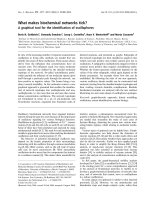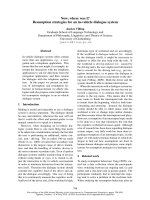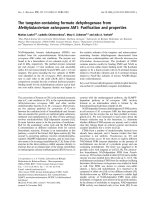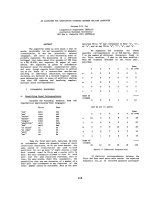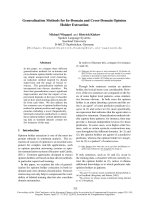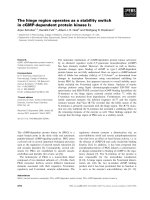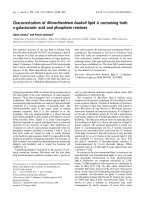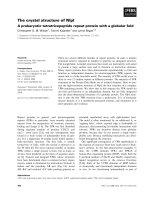báo cáo khoa học: " The Rx for Change database: a first-in-class tool for optimal prescribing and medicines use" ppt
Bạn đang xem bản rút gọn của tài liệu. Xem và tải ngay bản đầy đủ của tài liệu tại đây (2.41 MB, 9 trang )
METH O D O LOG Y Open Access
The Rx for Change database: a first-in-class tool
for optimal prescribing and medicines use
Michelle C Weir
1
, Rebecca Ryan
2
, Alain Mayhew
1
, Julia Worswick
1
, Nancy Santesso
2,3
, Dianne Lowe
2
, Bill Leslie
4
,
Adrienne Stevens
1
, Sophie Hill
2
, Jeremy M Grimshaw
1,5,6*
Abstract
Background: Globally, suboptimal prescribing practices and medication errors are common. Guidance to health
professionals and consumers alone is not sufficient to optimise behaviours, therefore strategies to promote
evidence-based decision making and practice, such as decision support tools or reminders, are important. The
literature in this area is growing, but is of variable quality and dispersed across sources, which makes it difficult to
identify, access, and assess. To overcome these problems, by synthesizing and evaluating the data from systematic
reviews, we have developed Rx for Change to provide a comprehensive, online database of the evidence for
strategies to improve drug prescribing and use.
Methods: We use reliable and valid methods to search and screen the literature, and to appraise and analyse the
evidence from relevant systematic reviews. We then present the findings in an online format which allows users to
easily access pertinent information related to pre scribing and medicines use. The database is a result of the
collaboration between the Canadian Agency for Drugs and Technologies in Health (CADTH) and two Cochrane
review groups.
Results: To capture the body of evidence on interventions to improv e prescribing and medicines use, we conduct
comprehensive and regular searches in multiple databases, and hand-searches of relevant journals. We screen
articles to identify relevant systematic reviews, and include them if they are of moderate or high methodological
quality. Two researchers screen, assess quality, and extract data on demographic details, intervention characteristics,
and outcome data. We report the results of our analysis of each systematic review using a standardised
quantitative and qualitative format. Rx for Change currently contains over 200 summarised reviews, structured in a
multi-level format. The reviews included in the database are diverse, covering various settings, conditions, or
diseases and targeting a range of professional and consumer behaviors.
Conclusions: Rx for Change is a novel database that synthesizes current research evidence about the effects of
interventions to improve drug prescribing practices and medicines use.
Background
The safe and effective use of medicines is an important
aspect of quality healthcare. While there is an abun-
dance of d ata on the clinical effectiveness and safety of
variousdrugs,thisdoesnotensure that the drugs are
being appropriately prescribed or taken; in fact, subopti-
mal prescribing and medication errors are common
across countries [1]. Research has indicated that gui-
dance to health professionals and consumers alone does
not reliably change behavior, and clinical practice is
often based on personal beliefs rather than on scientific
evidence [2]. In order to improve professional practice,
approaches that have been shown to be effective should
be used to promote optimal decision making and patient
care [3]. To date, a large body of evidence evaluating the
effectiveness of inter ventions to change clinical practice
has been produced [4,5]. However, the volume of this
literature, its w ide dispersion, and its variable quality
make it difficult for decision makers to access, assemble,
and assess this evidence [6].
To address these problems, the Canadian Optimal
Medication Prescribing and Utilization Service
* Correspondence:
1
Institute of Population Health, University of Ottawa, 1 Stewart Street,
Ottawa, ON, K1N 6N5, Canada
Full list of author information is available at the end of the article
Weir et al. Implementation Science 2010, 5:89
/>Implementation
Science
© 2010 Weir et al; licensee BioMed Central Ltd. Thi s is a n Open A ccess article d istributed under the terms of the Creative Commons
Attribution License ( whi ch permits u nrestrict ed use, distribution, and reproduction in
any medium, provided the original work is properly cited.
(COMPUS) program, within the Canadian Agency for
Drugs and Technologies in Health (CADTH), and
in collaboration with the Cochrane E ffective Practice
and Organisation of Care (EPOC) Group and the
Cochrane Consumers and Communication Review
Group (CC&CRG), have created and continue to
update an online dat abase of interventions to pro mote
evidence-based prescribing and medicines use, called
Rx for Change .
Rx for Change is a novel, publicly-accessible database
that we initially developed and populated with review-
level evidence, and made available online in April 2007.
We update it regularly to reflect accumulating and
changing evidence and provide decision makers with
reliable, up-to-date, evidence-based information in the
form of reader-friendly summaries. In the database, we
present key findings from systemat ic re views that evalu-
ate the effects of intervention s dire cted at profe ssionals,
consumers, and organizations in a systematic way. This
paper d escribes the methods for developing and popu-
lating the Rx for Change database and highlights key
content and the significance of the database for health-
care policy makers, researchers, professionals, and
consumers.
Methods
Design and procedure
Our goal for the Rx for Change database is to provide an
overall synthesis of the evidence from systematic reviews
on the effectiveness of interventions for improving pre-
scribing by healthcare p rofessionals and medicines use
by consumers. The methods that we used to populate
the database parallels systematic review methodolo gy.
We use reliable and valid methods to search and screen
the literature, and to appraise and analyse the evidence
from relevant systematic reviews. We then present the
findings in an online format which allows users to easily
access pertinent information related to prescribing and
medicines use.
Contributors
In partnership with the Canadian Federal, Provincial,
and Territorial Health Ministries, COMPUS identifies
and promotes optimal drug therapy and encourages evi-
dence-based information in decision making among
healthcare providers and consumers. COMPUS hosts
the Rx for Change database onli ne in a publicly accessi-
ble format and has recruited additional funding for this
project.
EPOC produces systematic reviews of interventions to
improve healthcare delivery and healthcare systems,
such as audit and fe edback, distribution of educational
materials, and decision-support tools using a well-estab-
lished t axonomy of interventions and methods. In
addition, EPOC has conducted overviews of existing
Cochrane reviews as well as non-Cochrane systematic
reviews to assess and synthesise the evidence in the
area of professional behavior change [4,5]. For the Rx
for Change database, EPOC maintains and updates the
evidence from published systematic reviews on profes-
sional interventions that im pact on the deli very of care,
as well as organisational, financial, and regulatory inter-
ventions that influence prescribing behaviour. For the
purpose of this paper, the metho ds us ed to identify and
evaluate interventions targeting prescribing will be
described.
The CC&CRG produces systematic reviews of inter-
ventions targeted at consumers (patients and their
family members or carers) to promote consumer partici-
pation in healthcare. The CC&CRG has developed
resources and tools to help organise a nd synthesise the
evidence in relation to consumer communication and
participation, and members of the group are currently
undertaking an overview of systematic reviews of inter-
ventions directed at consumers to improve medicines
use [7]. For the Rx for Change database, the CC&CRG is
responsible f or maintaining and updating the evidence
on the effect of consumer-targeted interventions, such
as providing consumers with information or education
on medicines use, or promoting medicines self-manage-
ment skills among consumers.
Using the combined expertise of the two Cochrane
review groups, we d eveloped the methods used for the
synthesis and the presentation of the findings for this
database. Human resources required in successfully
maintaining Rx for Change equals four highly trained
staff members shared between both Cochrane groups, in
addition to supervision from senior research staff.
Results
Identifying systematic reviews: searching and screening
With the assistance of an informatio n specialist, we
conduct comprehensive regular searches of electronic
databases, including MEDLINE, EMBASE, Database
of Abstracts of Reviews of Effects (DARE), and the
Cochrane Database of Systematic Reviews (CDSR). In
addition, we systematically hand-search the CDSR and
DARE databases as interventions targeting consumers’
use of medicines are not well indexed.
Each year, we identify several thousand potentially
eligible citations. Using explicit inclusion criteria, two
resear chers independently screen titles, abstracts and full
text articles for relevance, and compare results. We resolve
disagreements through discussion and, when necessary,
through consultation with a senior team member (further
details relating to selection criteria and methods are
available o nline: />compus/optimal-ther-resources/interventions/methods).
Weir et al. Implementation Science 2010, 5:89
/>Page 2 of 9
A flow diagram illustrating the methods and procedures
for the database can be found in Figure 1.
Quality assessment of systematic reviews
End users can be more confident in the results of sys-
tematic reviews that are of higher methodological quality.
For this reason, two researchers critically appraise each
review identified as eligible for inclusion in the database
using the AMSTAR tool, a validated instrument for
appraising systematic reviews [8]. AMSTAR is an
11-item checklist on which reviews score one point for
each criterion met. Items assess methodological criteria
such as the comprehensiveness of the search used and
whether the quality of included studies was evaluated
and accounted for. In consultation with AMSTAR
developers, we created decision rules for each of the 11
items to facilitate an objective and consistent assessment
across reviews.
Figure 1 Flow chart describing methods and procedures of Rx for Change (as of April 2010).
Weir et al. Implementation Science 2010, 5:89
/>Page 3 of 9
Reviews are eligible to be summarised on the database
if the y achieve an AMSTAR score greater than 3. This
decision was based on our experience that it is difficult
to draw meaningful conclusions based on data from
low-quality reviews. We make the bibliographic details
and A MSTAR scores of these reviews available on the
database under the heading ‘Excluded Reviews.’ To date,
we have assigned approximately two-thirds of eligible
reviews an AMSTAR score greater than 3, and have
summarised these reviews on the database.
Data extraction
When dec iding what information should be abstracted
from the individual reviews, we focused on information
that is useful to decision makers. Two researchers
independently extract data on demographic details,
Figure 2 Screenshot 1 of Rx for Change database. Level 1: Identifies intervention categories (professional, consumer, organizational etc.) and
specific interventions (audit and feedback, acquiring skills and competencies, et al.).
Weir et al. Implementation Science 2010, 5:89
/>Page 4 of 9
intervention characteristics, and outcomes from each
review using a standardised data extraction form and a
consensus process. This ensures a consistent summary
format for each review and ensures the accurac y of the
information.
Analysis and synthesis
We analyse, summarise, and report separately the
results of all relevant comparisons within each sys-
tematic review using quantitative and qualitative meth-
ods as appropriate. Because reviews vary greatly in the
type and amount of study data reported, we often use
vote counting for data synthesis to allow for consistent
presentation of results. We report our analyses by vote
counting as the number of studies that favor the inter-
vention (based on direction of effect) out of the total
number of studies for each comparison. We also
include any additional review data, such as meta-
analyses or effect sizes. We then compile the results
from each comparison and present them in a ‘Table of
Results.’ We use standardised decision rules and
statements to descriptively report on the general and
medicines-specific ‘Results’ and ‘ Conclusions’ of each
review. For example, we use the term ‘generally effec-
tive’ if two-thirds or more of the studies favor the
intervention.
Figure 3 Screenshot 2 of Rx for Change database. Level 2: Provides evidence summaries within each intervention, with links to systematic
review-level evidence summaries.
Weir et al. Implementation Science 2010, 5:89
/>Page 5 of 9
Figure 4 Screenshot 3 of Rx for Change database. Level 3: Provides synthesis of systematic review-level evidence.
Weir et al. Implementation Science 2010, 5:89
/>Page 6 of 9
We organize the r eviews of interventions directed to
professionals and the delivery of care using the EPOC
taxonomy of interventions. This taxonomy groups inter-
vent ions into five broad categories: interventions t arget-
ing healthcare professionals, changing the organization
of healthcare, financial interventions, regulatory
interventions, and structural changes. Each category
includes a number of specific interventions. Examples of
interventions t argeting professionals include reminders,
educational meetings, and audit and feedback. Because
the consumer literature on medicines use had not been
previously well organised, the CC&CRG developed a
Figure 5 Screenshot 4 o f Rx for Change database. Level 4: Provides a list of included studies within a systematic review, with links to
PubMed.
Weir et al. Implementation Science 2010, 5:89
/>Page 7 of 9
taxonomy of consumer directed interventions [9,10].
Examples of interventions include the provision of infor-
mation or education and behaviour change support. We
provide definitions of each interventio n on the database.
For each intervention, we summarise the evidence from
all of the relevant systematic reviews. We create each
intervention summary based on our findin gs from high
quality and key reviews, and this includes a statement of
the overall effectiveness of the intervention and the find-
ings as they relate to prescribing and medicines use. For
those interventions where no reviews were identified, we
include a comment in the database, informing the users
that there is a lack of review evidence.
With each update of the database, we combine new evi-
dence with existing evidence and intervention summaries
are updated. We display flags that indicate which inter-
ventions have been recently updated with new evidence.
We present the database in a multilevel approach. In
the first level, we provide a list of interventions grouped
into five categories: professional, consumer, organisa-
tional, financial, and regulato ry (Figure 2). In the second
level, we provide intervent ion summaries based on the
findings from high quality and key systematic reviews
(Figure 3). In the third level, we provide a summary of
findings from the included studies in each systematic
review (Figure 4). In the fourth level, we provide links to
the studies included in each systematic review (Figure 5).
Implementation
We launched the database in April 2007 and have since
updated it three times (Table 1). We initially populated
it with approximately 50 reviews, and it now contains
over 200 summarised reviews (as of April 2010). The
reviewsthatwehaveincludedinthedatabaseare
diverse, spanning various settings, conditions, or dis-
eases, and targeting a range of professionals, healthcare
systems, and consumers. Details regarding the epide-
miology and quality of reviews included in the Rx for
Change database on professional behaviour change [11]
and consumer-focused interventions [7] can be found
elsewhere.
Discussion
Rx for Change is a well-designed database contain-
ing valuable information for researchers, healthcare
providers, and policy m akers. Since its inception, we
have received positive feedback about the database from
international users about its value, applicability, and
quality. Within a year of its launch, it had accumulated
more than 25,000 page views. With increasing awareness
of the database and its ongoing updates, we anticipate
that this interest will continue to grow. We will con-
tinue to disseminate key messages to local and interna-
tional groups a bout which inte rventions are effective,
andwheregapsintheevidenceexist.Wewillcontinue
to explore methods to disseminate and translate key
messages to end users, particularly as new evidence is
found and added to the database.
The Rx for Change database has provided the opportu-
nity for EPOC and CC&CRG to collaborate with organiza-
tions that have strong links with healthcare decision
makers (e.g., CADTH, National Prescribing Service
Australia). This collaboration promotes the use of research
evidence and ensures that the data is available to the gen-
eral public, healthcare professionals, and policy makers.
Summary
We created the Rx for Change database to facilitate and
improve the processes of accessing, searching, identifying,
and using research to inform evidence-based prescri bing
and medicines use. It provides reliable, up-to-date,
evidence for a wide range of users and is organised in an
easy-to-browse format. We take the quality of the evi-
dence into consideration to provide useable summaries
that are relevant to decision-makers. This database is a
first-in-class tool, and we will continue to promote it to
ensure that it is utilized to its full potential.
Acknowledgements
The authors gratefully acknowledge the Canadian Agency for Drugs and
Technologies in Health (CADTH), for making this project possible. We also
thank the Canadian Institutes for Health Research, KT Canada, and the
National Prescribing Service for their generous contributions to this project.
Jeremy Grimshaw holds a Canada Research Chair in Health Knowledge
Transfer and Uptake. We acknowledge the contributions of Doug Salzwedel,
Jessie McGowan and Michelle Fiander for their work in literature searching
for this project; and to Carolyn Wayne for help in editing the manuscript.
Author details
1
Institute of Population Health, University of Ottawa, 1 Stewart Street,
Ottawa, ON, K1N 6N5, Canada.
2
Centre for Health Communication and
Participation, Australian Institute for Primary Care and Ageing, La Trobe
University, Melbourne, VIC, 3086, Australia.
3
Department of Clinical
Epidemiology and Biostatistics, McMaster University, 1200 Main Street West,
Hamilton, ON, L8N 3Z5, Canada.
4
Canadian Agency for Drugs and
Technologies in Health, 600-865 Carling Avenue, Ottawa, ON, K1 S 5S8,
Canada.
5
Clinical Epidemiology Program, Ottawa Health Research Institute,
1053 Carling Avenue, Administration Building, Room 2-017, Ottawa ON, K1Y
4E9, Canada.
6
Department of Medicine, University of Ottawa, Ottawa, ON,
Canada.
Authors’ contributions
MW participated in the design, data collection, analysis, coordination of the
study, and drafted the manuscript. RR, AM, JW, NS, DL, AS, and SH
participated in the design, data collection, analysis, and coordination of the
Table 1 Number of systematic reviews on Rx for Change
at each update
Update No. consumer reviews No. professional reviews
April 2007 21 23
April 2009 33 82
October 2009 53 124
April 2010 63 155
Weir et al. Implementation Science 2010, 5:89
/>Page 8 of 9
study and contributed to the manuscript. BL participated in the design of
the study and provided feedback on the manuscript. JG conceived of the
study, participated in its design and coordination and provided feedback on
the manuscript. All authors read and approved the final manuscript.
Competing interests
BL is currently employed by CADTH. MW, AM, JW, and AS have been or are
currently employed by EPOC. JG is the Coordinating Editor of EPOC. RR, NS
and DL are currently employed by CC&CRG. SH is the Coordinating Editor of
CC&CRG.
Received: 13 August 2010 Accepted: 18 November 2010
Published: 18 November 2010
References
1. Schoen C, Osborn R, Huynh PT, Doty M, Zapert M, Peugh J, al. e: Taking
the pulse of health care systems: experiences of patients with health
problems in six countries. Health Affairs (web exclusive) 2005, W5-
509-W505-525.
2. Grol R: Personal paper. Beliefs and evidence in changing clinical practice.
BMJ 1997, 315(7105):418-421.
3. Grimshaw JM, Eccles MP, Walker AE, Thomas RE: Changing physicians’
behavior: what works and thoughts on getting more things to work.
J Contin Educ Health Prof 2002, 22(4):237-243.
4. Grimshaw JM, Shirran L, Thomas R, Mowatt G, Fraser C, Bero L, et al:
Changing provider behavior: an overview of systematic reviews of
interventions. Med Care 2001, 39(Suppl 2):II2-45.
5. Bero LA, Grilli R, Grimshaw JM, Harvey E, Oxman AD, Thomson MA: Closing
the gap between research and practice: an overview of systematic
reviews of interventions to promote the implementation of research
findings. The Cochrane Effective Practice and Organization of Care
Review Group. BMJ 1998, 317(7156):465-468.
6. Lavis JN, Davies HT, Gruen RL, Walshe K, Farquhar CM: Working within and
beyond the Cochrane Collaboration to make systematic reviews more
useful to healthcare managers and policy makers. Healthc Policy 2006,
1(2):21-33.
7. Ryan R, Santesso N, Hill S, Kaufman C, Grimshaw J: Consumer-oriented
interventions for evidence based prescribing and medicine use: an
overview of Cochrane reviews. Cochrane Database of Systematic Reviews
2009, , 2: CD007768.
8. Shea BJ, Bouter LM, Peterson J, Boers M, Andersson N, Ortiz Z, Ramsay T,
Bai A, Shukla VK, Grimshaw JM: External validation of a measurement tool
to assess systematic reviews (AMSTAR). PLoS One 2007, 2(12):e1350.
9. Ryan R, Lowe D, Santesso N, Hill S: Development of a taxonomy of
interventions directed at consumers to promote evidence-based
prescribing and medicines use: a tool for evidence-based decision-
making (Poster session 3: Safe and effective use). National Medicines
Symposium: 26-28 May 2010; Melbourne 2010 [ />pdf/nps_nms_2010abstracts.pdf].
10. Lowe D, Ryan R, Santesso N, Hill S: Development of a taxonomy of
interventions to organise the evidence on consumers’ medicines use.
Patient Education and Counseling 2010.
11. Weir M, Mayhew A, Worswick JFD, Grimshaw J: The Epidemiology and
Quality of Systematic Reviews of Health Professional Behaviour Change
Interventions. 17th Cochrane Colloquium: 11-14 October 2009; Singapore
2009 [ />8042].
doi:10.1186/1748-5908-5-89
Cite this article as: Weir et al.: The Rx for Change database: a first-in-
class tool for optimal prescribing and medicines use. Implementation
Science 2010 5:89.
Submit your next manuscript to BioMed Central
and take full advantage of:
• Convenient online submission
• Thorough peer review
• No space constraints or color figure charges
• Immediate publication on acceptance
• Inclusion in PubMed, CAS, Scopus and Google Scholar
• Research which is freely available for redistribution
Submit your manuscript at
www.biomedcentral.com/submit
Weir et al. Implementation Science 2010, 5:89
/>Page 9 of 9


